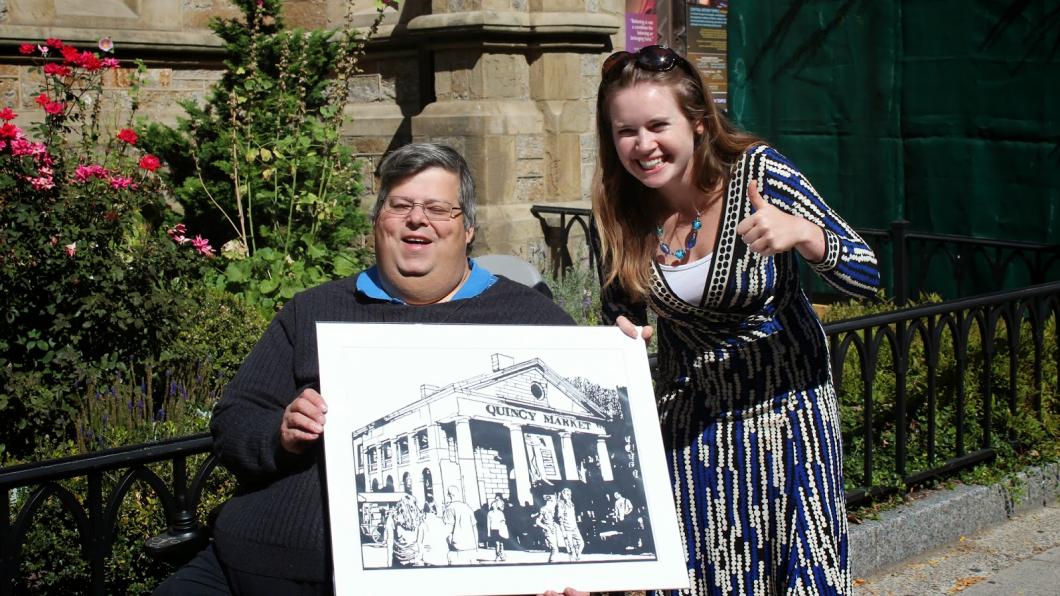
Disabled artists get a new platform for their work
By Megan Jones
Open the closet door in Liz Powers' Boston-area apartment, and you’ll come across a trove of artworks: a painting of a woman by the seaside, her soft purple dress billowing across the canvas; an image of a ship’s mast made of a single piece of paper, each detail painstakingly cut out by hand; an abstract painting of a pond populated by swans with backs that look like turtles’ shells.
All the works are created by artists who are homeless or low-income, or who have disabilities. Liz stores them in her apartment for safe-keeping, until they can be sold on ArtLifting, a website the Harvard graduate launched earlier this year with her brother, Spencer Powers.
The online gallery grew out of City Heart, an annual art show for homeless and low-income artists—some of whom have disabilities. Spencer and Liz started the show in 2011, and in the past three years, it's grown to include 70 artists from eight different homeless shelters.
At last year’s City Heart, the siblings were approached by impressed customers who wished they had more access to the artists’ work. “It was a recurring problem that tons of amazing work was created, but the artists didn’t have a good way to share the work with the community and sell it,” Liz says.
“Lots of people came up to us and said ‘Why just one day a year?’ We didn’t have a good answer, so we decided to start ArtLifting.”
The works for sale include original paintings, prints and iPhone cases. Artists help to set the price, specifying how much they expect to receive for their pieces. An additional sum is then added to make up the final sale price. That money goes towards maintaining the site, and purchasing supplies to support a number of community art groups ArtLifting partners with. Pieces range in price from $34 for an iPhone case, to several hundred dollars for larger works.
Four months after launching, the site has partnered with a roster of about 15 artists who are in their mid-20s to mid-60s. A few of these artists have physical disabilities: for example, ArtLifting recently signed on four participants who have quadriplegia. As the program expands, Liz and Spencer plan to work with artists with developmental disabilities as well as those creating art in hospitals and disability centres. As a college student, she wrote a thesis looking at the social benefits of art therapy.
Allen Chamberland, 48, has used a wheelchair since he was a child as a result of respiratory issues. He was one of the first artists to sign on with the website. He has been making art in a variety of forms his whole life, and currently uses paper-cutting techniques to create intricate images of landmarks like the Charles River Bridge and the Christian Science Church (he appears in the photo above with ArtLifting co-founder Liz). The pieces are so detailed that larger works can take the artist a whole week to complete, even when he dedicates four or five hours a day to cutting.
Allen says ArtlLifting gives him a sense of accomplishment. “It validates your work,” he says. “It feels really good when someone’s really willing to buy something you’ve spent so much time doing.”
It also allows opportunities to artists who might not normally get a chance to sell their pieces, he says. Prior to signing with ArtLifting, Allen relied on craft fairs to sell his work and supplement the income he received from disability benefits.
But weather-related mobility issues made it difficult for him to attend fairs in the winter. Sometimes Allen would go months without selling a piece. Since joining ArtLifting, he says his winter sales have been more successful. All but a couple of his pieces were sold through the site from November to January this year.
As the program grows, Spencer and Liz are looking to partner with hotels and businesses for larger, bulk sales. In the past few months, the siblings have been successful setting up two corporate contracts with business owners. They started ArtLifting using their own savings, but hope that soon, larger deals like these will allow the site to become self-sustaining.
The duo are aiming to expand their reach beyond the Boston area, empowering as many artists as possible by helping them support themselves financially, and showing the public what they’re capable of creating.
“For people with disabilities, a lot of times outsiders focus on the negative,” Liz says. “They say things like ‘Oh, that’s too bad you’re in a wheelchair.’ But ArtLifting is a strength-based program. We focus on people’s talents.”